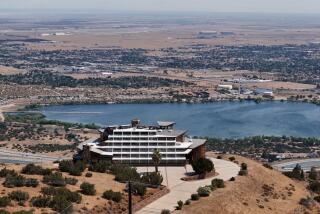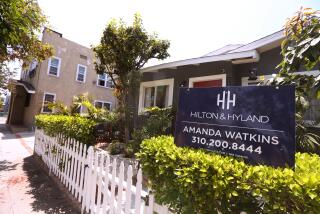The Westside, Home of the $1 Million Fixer-Upper
NO OTHER PART of the country boasts as many high-priced homes as the Westside of Los Angeles, which ranges from the palm-lined drives of Beverly Hills to the ocean-view cliffs of Malibu. Real estate agents have similarly spectacular estates to show their clients in such places as Palm Beach, Fla., and New York’s Park Avenue is lined with multimillion-dollar apartments. But for size and volume, the Westside has no equal, says Richard Merrill, whose Merrill Lynch Realty has offices in every major market of the country.
Last fall, the average sale price of homes and condominiums handled through Jon Douglas, Merrill Lynch Realty/Beverly Hills and Fred Sands Realtors--the three largest players, all of which do the bulk of their business on the Westside--was $400,000. During that time, the average home price nationwide was $106,500, and the average for the 13 Western states was $132,500, according to the National Assn. of Realtors. In the most expensive region of the nation, the Northeast, home prices averaged $147,200 in September.
Moreover, between April, 1986, and April, 1987, the Westside--along with Pasadena and its surrounding communities--experienced the largest overall price increase in Los Angeles County at 14.7%, according to a study by the Real Estate Research Council of Southern California at California State Polytechnic University, Pomona. On the other hand, the Westside market historically has demonstrated more volatility: While home prices plateaued in most of the county during the recession in the early 1980s, they dropped on the Westside.
Today, prices of single-family homes on the Westside range from close to $200,000 to as much as $25 million for estate properties. In the most chic neighborhoods, like parts of Beverly Hills, $1 million won’t buy much more than a fixer-upper. “For $1 million, in most cases, you would get a house in need of remodeling on a very small lot. It wouldn’t be large, and it would probably be in need of major repair,” says Joyce Rey, general manager of Rodeo Realty, a Merrill Lynch division. “Builders are now paying $1.2 million to $1.8 million for a house and tearing it down to get the lot.”
Even at those prices, low interest rates led to a seller’s market on the Westside in 1987. While the market has calmed down since the fall, real-estate brokers use terms such as “hysteria buying” and “overheated” to describe the first months of 1987 on the Westside. Houses went on sale and were often snapped up within days. Frustrated sales agents complained about a lack of inventory. In the early part of the year, it was not unusual for a buyer to offer a premium over the asking price simply to outbid competitors.
The result of so much cash chasing the homes in these neighborhoods is sometimes startling. In one case, a wealthy young high-tech entrepreneur saw three multimillion-dollar estates one afternoon and at the end of his tour turned to his Fred Sands broker and asked which one he should choose. He didn’t really care which one he bought, but he wanted the broker to hurry up and decide: He had a party to go to in an hour and didn’t want to be late.
The prices are kept high, in part, because money flows into this lovely locale from around the world and from a wide range of industries. Old money, new money, entertainment money, oil money, the proceeds of taxes on distant Third World nations--it’s all there on the Westside.
“There’s a psychological mystique attached to the Westside. Everyone in the world has heard of Beverly Hills, of the beaches in Santa Monica and Venice and Malibu. These are places people all over the world dream about living,” says Lou Piatt, executive vice president/sales of Jon Douglas Co. It’s also where investors all over the world dream about speculating, another factor that has kept prices in the area high.
What does all this mean for the average home buyer? Is the Westside going so upscale that it will one day be solely a playground for the rich and famous? In order to buy that average $400,000 home, a typical family would need well over $40,000 in savings and an annual income of roughly $120,000. Only 2.2% of the households in the nation have pre-tax incomes of more than $100,000.
But there’s a flip side to that, Piatt argues. Because of the city’s diverse economy, real-estate prices throughout Los Angeles have risen dramatically. So it’s not uncommon to find a family with an average income that has paid off the mortgage and sold their home, leaving a couple of hundred thousand dollars in the bank. “People don’t buy their first homes in Beverly Hills,” says Piatt. “Once you can get on the merry-go-round, you can work your way through the marketplace. Most of us buy homes not on our incomes, but on our equity investments.”
More to Read
Inside the business of entertainment
The Wide Shot brings you news, analysis and insights on everything from streaming wars to production — and what it all means for the future.
You may occasionally receive promotional content from the Los Angeles Times.










